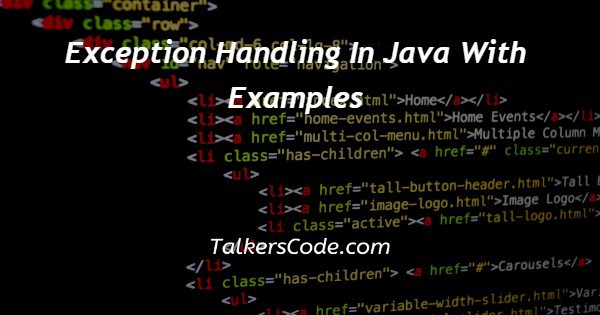Exception Handling In Java With Examples
Last Updated : Mar 11, 2024
IN - Java | Written & Updated By - Riya

In this article we will show you the solution of exception handling in java with examples, one of the effective ways for handling runtime issues brought on by exceptions in Java is exception handling.
Exception management is crucial to software development. This article aids in your understanding of java exceptions, java exception management, java exception hierarchy, different forms of java exceptions, and many other concepts.
Step By Step Guide On Exception Handling In Java With Examples :-
Java's exception handling contributes to exception minimization and exception recovery.
It is one of the effective methods for handling runtime errors and ensures that the programme is bug-free.
Exception handling aids in keeping the program's flow intact. An abnormal circumstance that might arise at runtime and obstruct the program's usual flow is referred to as an exception.
When an exception occurs inside of a method, the method creates an object called an Exception Object and passes it on to the run-time system (JVM).
The name, description, and current programme state of the programme where the exception has occurred are all contained in the exception object.
Throwing an exception refers to creating the Exception Object and managing it in the run-time system.
A list of the methods that had been used to arrive to the method where the exception occurred might be present.
The term "call stack" refers to this hierarchy of the methods. The subsequent process will now take place.
In order to locate the method that has a block of code that can handle the encountered exception, the run-time system traverses the call stack. An exception handler is the name given to the section of code.
The search is conducted by the run-time system starting from the method where the exception occurred and moving across the call stack in the reverse order of the methods' call orders.
If it discovers a suitable handler, it sends the thrown exception to that person.
When an exception object is thrown, its type must match the exception object type that the handler may handle.
The default exception handler, which is a component of the run-time system, will receive the Exception Object if the run-time system has searched all the methods on the call stack and was unable to find the right handler.
The application is abruptly terminated by this handler after printing the exception details in the format shown below.
// Java Program to Demonstrate
// Need of try-catch Clause
// Class
class GFG {
// Main driver method
public static void main(String[] args)
{
// Taking an array of size 4
int[] arr = new int[4];
// Now this statement will cause an exception
int i = arr[4];
// This statement will never execute
// as above we caught with an exception
System.out.println("Hi, I want to execute");
}
}
- Creating Class GFG
- Creating the Main Driver method
- Taking an array of size 4
- Now this statement will cause an exception
- The following statement will never execute.
- Run the code
Conclusion :-
So, in this tutorial we learned about the types of exception handling that takes place in Java. Exception handling is a pretty powerful mechanism in Java.
I hope this article on exception handling in java with examples helps you and the steps and method mentioned above are easy to follow and implement.













